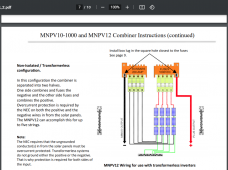D
Deleted member 23531
Guest
This device "(PNL-GFDI-80D) is designed for use with systems that have two charge controllers that are fed by two separate PV arrays". If you look at the documentation they don't show both leads (+) and (-) going through the device using the two poles, but rather two (+) leads from two separate arrays using the two poles. (Page 9 shows the dual pole wiring). This is similar to standard house wiring how the breakers are on the hot leads and the neutral leads are just shorted together using a bus bar.This is a 2 pole pv ground fault interrupt device
I believe this part from OutBack is functionally equivalent to the Midnite GFP device I mentioned above. The only difference, I think, is that they sell it in a 2x version for two separate arrays protected by the same negative-to-ground sensor. The Midnite part is for a single array.
Edit: I guess another difference is they show it positioned between the solar charger and the battery, as opposed to between the PV and the solar charger. I think I'd rather put it between the PV and the solar charger since it seems more likely a short would develop in the wiring to all the panels and the panels themselves than on the solar charger / battery connection. But, this is just a guess at which failure mode is more common.
Last edited by a moderator:



